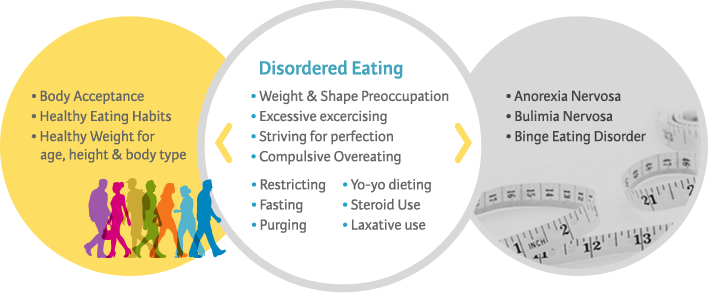What is Disordered Eating?
Disordered eating consists of a range of thoughts and feelings about food and body image that lie between healthy/normal eating habits with body acceptance at one end and eating disorders (anorexia, bulimia, or binge eating disorder) at the other. These behaviours are not just about eating. They include weight/shape preoccupation, a striving for perfection, yo-yo dieting, excessive exercising, fasting or restricting, compulsive overeating, purging, steroid use, and laxative abuse.

While some of these ways of acting are symptoms of an eating disorder they do not occur as often or to such an extreme that a doctor would consider them to be anorexia, bulimia, or binge eating disorder.
Disordered eating symptoms may occur once in a while or at certain key moments in your child’s life – as a result of a stressful event, illness or preparing for an athletic event. However, when disordered eating continues for long periods of time and starts to get in the way of your child’s everyday life and activities, or used to cope with strong feelings, it may lead to an eating disorder. Those “dabbling” in disordered eating are more at risk for eating disorders.
Who does it affect?
About one- tenth of the population are thought to be living with an eating disorder (greater numbers are found with dancers, models, actors and athletes) and one-tenth of that number are male. However, almost all women and girls over the age of eleven, have at one time indulged in disordered eating, most likely dieting. Research tells us that 81% of 10 year old are afraid of being fat and 98% of females are unhappy with their bodies.
The message our society sends is that “fat” is not okay and “thin” is cool. Happiness, it would seem, equals being thin, perfect and in control. The media helps to create and perpetuate this notion that can lead to many children and teens developing an unhealthy body image and creating ways to maintain it.
What can I do?
-
Find a parenting/teaching style based on kindness, fairness and consistency that also sets firm boundaries and realistic consequences.
-
Model the way you expect your children to act. Show them how to eat a variety of foods and exercise for fun and good health not to burn calories.
-
Maintain a family atmosphere where open and honest communication is valued and children are allowed to express their own opinions.
-
Let your children know you value inner beauty over outer beauty and refrain from making comments about looks and weight.
-
Model a balanced approach to eating and food, sit down to regular family meals, and don’t use food to bribe, reward or punish children.
-
Teach your children how to think critically. Give them room to disagree, and challenge conventional wisdom in order to resist the lure of media messages and peer pressure. Model how to think not what to think.
-
Let children know they are unique, valued and lovable just the way they are, not for how they look, the marks they get or their athletic ability.
If your child is already showing signs of disordered eating, it is important to get help before disordered eating becomes an eating disorder. Talk to a counsellor and be sure your child has regular visits to the doctor and dentist.
A nutritionist or dietitian can help you and your child learn about food and help your family create healthy meal plans. Call 811.
If binging or overeating is a concern, the Rudd Center for Food Policy at Yale University, www.yaleruddcenter.org, may provide some helpful suggestions.
Other ideas include:
-
Help your child learn stress management and problem solving strategies
-
Make sure your child keeps active and stays in touch with family and friends
-
Take time to do things with your child that your child enjoys.
-
Make sure your child is getting enough sleep



